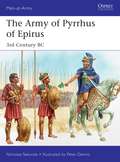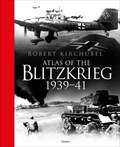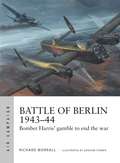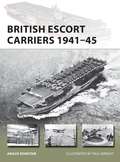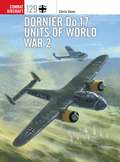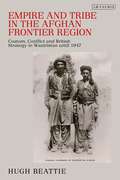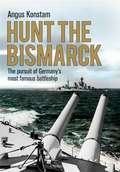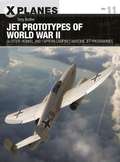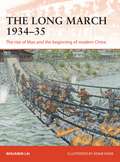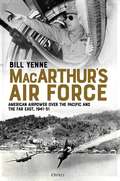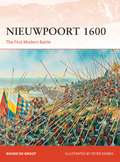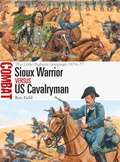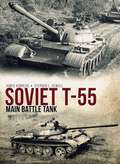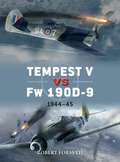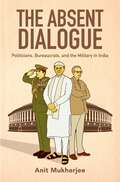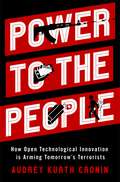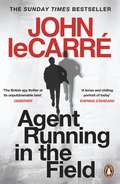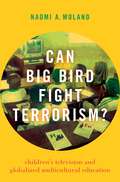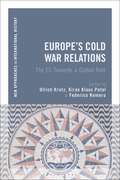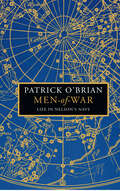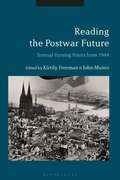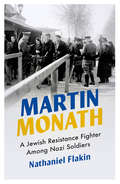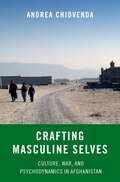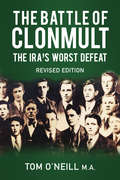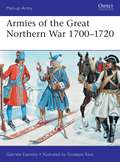- Table View
- List View
The Army of Pyrrhus of Epirus: 3rd Century BC (Men-at-Arms)
by Nicholas SekundaPyrrhus was one of the most tireless and famous warriors of the Hellenistic Age that followed the dispersal of Alexander the Great's brief empire. After inheriting the throne as a boy, and a period of exile, he began a career of alliances and expansion, in particular against the region's rising power: Rome. Gathering both Greek and Italian allies into a very large army (which included war-elephants), he crossed to Italy in 280 BC, but lost most of his force in a series of costly victories at Heraclea and Asculum, as well as a storm at sea. After a campaign in Sicily against the Carthaginians, he was defeated by the Romans at Beneventum and was forced to withdraw. Undeterred, he fought wars in Macedonia and Greece, the last of which cost him his life. Fully illustrated with detailed colour plates, this is the story of one of the most renowned warrior-kings of the post-Alexandrian age, whose costly encounters with Republican Rome have become a byword for victory won at unsustainable cost.
Atlas of the Blitzkrieg: 1939–41
by Robert KirchubelIn September 1939, Nazi Germany launched its infamous Blitzkrieg invasion of Poland, bringing about the outbreak of World War II. Faced with highly tactical and accelerated attacks aimed at disrupting the line of defence and encircling vulnerable troops, Allied forces broke under pressure. Within the space of a year, France had been invaded and occupied, while the forces of Great Britain had retreated headlong back across the Channel. Further campaigns in the air and at sea sought to subdue the British Isles, while more lightning-fast attacks in 1941 overran Yugoslavia and Greece, leaving the bulk of Continental Europe under Nazi control. Though the dominance of the Blitzkrieg method was to be challenged in the latter part of the war, as Allied forces found methods of disrupting the attacks and dominating the battlefields, its unparalleled success in the early years of the conflict brought Europe to its knees. Featuring 107 detailed maps, this impressive atlas shows, in intricate detail, the fighting and physical challenges faced by the German attackers and Allied defenders. This will be a treasure for World War II enthusiasts and collectors alike.
Battle of Berlin 1943–44: Bomber Harris' gamble to end the war (Air Campaign)
by Richard WorrallThroughout late-1943 into early-1944, an epic struggle raged over the skies of Germany between RAF Bomber Command and the Luftwaffe. This campaign had been undertaken by the Commander-in-Chief Bomber Command, Air Chief Marshal Sir Arthur Harris, and was baptized 'The Battle of Berlin'. The Berlin campaign was a hard, desperate slog. Struggling against dreadful and bitter winter weather, Bomber Command 'went' to Berlin a total of sixteen times, suffering increasingly severe losses throughout the winter of 1943/44 in the face of a revitalized German air-defence. The campaign remains controversial and the jury, even today, is ultimately undecided as to what it realistically achieved. Illustrated throughout with full-colour artwork depicting the enormous scale of the campaign, this is the story of the RAF's much debated attempt to win the war through bombing alone.
British Escort Carriers 1941–45 (New Vanguard)
by Angus KonstamIn 1941, as the Battle of the Atlantic raged and ship losses mounted, the British Admiralty desperately tried to find ways to defeat the U-Boat threat to Britain's maritime lifeline. Facing a shortage of traditional aircraft carriers and shore-based aircraft, the Royal Navy, as a stopgap measure, converted merchant ships into small 'escort carriers'. These were later joined by a growing number of American-built escort carriers, sent as part of the Lend-Lease agreement. The typical Escort Carrier was small, slow and vulnerable, but it could carry about 18 aircraft, which gave the convoys a real chance to detect and sink dangerous U-Boats. Collectively, their contribution to an Allied victory was immense, particularly in the long and gruelling campaigns fought in the Atlantic and Arctic. Illustrated throughout with detailed full-colour artwork and contemporary photographs, this fascinating study explores in detail how these adaptable ships had such an enormous impact on the outcome of World War II's European Theatre.
Dornier Do 17 Units of World War 2 (Combat Aircraft)
by Chris GossInitially designed as a high-speed mail aeroplane and airliner, the Do 17 first made an appearance as a military aircraft in the Spanish Civil War, both as a bomber and in reconnaissance roles. In the early stages of World War II, it, together with the Heinkel He 111, formed the backbone of the German bomber arm over Poland, France, Belgium and the Low Countries, and saw action in almost every major campaign in this period. However, by the start of the Battle of Britain, the Do 17's limited range and small bomb load meant that it was ripe for replacement by the Ju 88. Though it performed well at lower altitudes, the model suffered heavy losses during raids, particularly during the Blitz and were increasingly phased out. This fully illustrated study uses detailed full-colour artwork and authoritative text from an expert author to tell the full operation story of one of Nazi Germany's best light bombers from the early years of World War II.
Empire and Tribe in the Afghan Frontier Region: Custom, Conflict and British Strategy in Waziristan until 1947
by Hugh BeattieWaziristan, a region on the border between Afghanistan and Pakistan, has in recent years become a flash point in the so-called 'War on Terror'. Hugh Beattie looks at the history of this region, examining British attempts to manage the tribes from 1849 until Pakistan's declaration of independence in 1947. He explores British attempts to divide the frontier region into separate British and Afghan spheres of influence. In the minds of British policymakers, this demarcation would secure the position of the Empire, and so Beattie highlights the various policy initiatives towards the frontier region over the period in question. Crucially, he analyses how the British perceived the local tribes, what constituted authority within tribal frameworks, and the military and political ramifications of these perceptions. As he also explores the contemporary relevance of this region, taking into account the resurgence of the Taliban in Waziristan, Beattie's analysis is vital for those interested in the history and security implications of the Afghan frontier with Pakistan.
Hunt the Bismarck: The pursuit of Germany's most famous battleship
by Angus KonstamHunt the Bismarck tells the story of Operation Rheinübung, the Atlantic sortie of the Nazi Germany's largest battleship in May 1941. Bismarck entered service in the summer of 1940. She was well-armed, with eight 15-inch guns as well as a powerful array of lighter weapons, while her armoured protection earned her the reputation of being unsinkable. This claim was finally put to the test in May 1941, when she sortied into the Atlantic and fought the legendary battle of the Denmark Strait, destroying HMS Hood, the pride of the Royal Navy. Bismarck was now loose in the North Atlantic. However, damage sustained in the battle limited her ability to roam at will, while the Royal Navy deployed the Home Fleet to revenge the Hood. The stage was set for the greatest chase story in the history of naval warfare. Drawing on a wealth of first-hand accounts, and intertwining extensive research into a fast-paced narrative, this is the most readable and accurate account of Bismarck's epic voyage ever produced.
Jet Prototypes of World War II: Gloster, Heinkel, and Caproni Campini's wartime jet programmes (X-Planes)
by Tony ButtlerWhile World War II raged, pioneering aircraft and engine designers were busy developing the world's first practical jet-powered research aircraft to test and prove the new technology. This book examines the aircraft that paved the way for Germany's Me 262 and Britain's Meteor - the world's first jet fighters. Throughout the war, Germany, Italy and Britain engaged in top-secret jet programmes as they raced to develop the airpower of the future. Various experimental aircraft were trialled in order to achieve the goal of producing an effective engine and fighter that could harness the potential of the jet power. These included the German Heinkel He 178 research aircraft and Heinkel He 280 jet fighter prototype, the famed British E.28/39 research aircraft built by Gloster Aircraft as well as the stillborn E.5/42 fighter and E.1/44 Ace fighter prototype, and finally the remarkable Italian Caproni-Campini N.1/CC 2 research aircraft.Illustrated throughout with full-colour artwork and rare photographs, this fascinating study examines the fore-runners to the military jet age.
The Long March 1934–35: The rise of Mao and the beginning of modern China (Campaign)
by Benjamin LaiEvery nation has its founding myth, and for modern China it is the Long March. In the autumn of 1934, the Chinese Nationalists under Chiang Kai-shek routed the Chinese Communists and some 80,000 men, women and children left their homes to walk with Mao Zedong into the unknown. Mao's force had to endure starvation, harsh climates, and challenging terrain whilst under constant aerial bombardment and threatened by daily skirmishes. The Long March survivors had to cross 24 rivers and 18 mountain ranges, through freezing snow and disease-ridden wilderness to reach their safe-haven of Yan'an. In military terms, the Long March was the longest continuous march in the history of warfare and it came as a terrible cost – after one year, 6,000 miles and countless battles, fewer than 4,000 of the original marchers were left. Illustrated with stunning full-colour artwork, this enthralling book tells the full story this epic display of resilience, and shows how, from the desert plateau of Yan'an, these survivors would grow the army that conquered China 14 years on, changing history forever.
MacArthur’s Air Force: American Airpower over the Pacific and the Far East, 1941–51
by Bill YenneGeneral Douglas MacArthur is one of the towering figures of World War II, and indeed of the twentieth century, but his leadership of the second largest air force in the USAAF is often overlooked. When World War II ended, the three numbered air forces (the Fifth, Thirteenth and Seventh) under his command possessed 4,004 combat aircraft, 433 reconnaissance aircraft and 922 transports. After being humbled by the Japanese in the Philippines in 1942, MacArthur and his air chief General George Kenney rebuilt the US aerial presence in the Pacific, helping Allied naval and ground forces to push back the Japanese Air Force, re-take the Philippines, and carry the war north towards the Home Islands. Following the end of World War II MacArthur was the highest military and political authority in Japan, and at the outbreak of the Korean War in June 1950 he was named as Commander in Chief, United Nations Command. In the ten months of his command his Far East Air Forces increased dramatically and saw the first aerial combat between jet fighters. Written by award-winning aviation historian Bill Yenne, this engrossing book traces the journey of American air forces in the Pacific under General MacArthur's command, from their lowly beginnings to their eventual triumph over Imperial Japan, followed by their entry into the jet age in the skies over Korea.
Nieuwpoort 1600: The First Modern Battle (Campaign)
by Bouko de GrootThe Eighty Years' War began as a limited Dutch rebellion seeking only religious tolerance from their Spanish overlords, but it quickly escalated into one of the longest wars in European history. Spain's failed invasion of 1599 and the mutinies that followed convinced Dutch leaders that they now should go on the offensive. This campaign pitted two famous leaders' sons against each other: Maurice of Nassau and Archduke Albert VII. One led an unproven new model army, the other Spain's 'unbeatable' Tercios, each around 11,000-men strong. The Dutch wanted to land near Nieuwpoort, take it and then march on to Dunkirk, northern home port of the Spanish fleet, but they were cut off by the resurgent and reunited Spanish army. The two forces then met on the beach and in the dunes north of Nieuwpoort. This book uses specially commissioned artwork to reveal one of the greatest battles of the Eighty Years' War – one whose influence on military theory and practice ever since has been highly significant.
Sioux Warrior vs US Cavalryman: The Little Bighorn campaign 1876–77 (Combat)
by Ron FieldFollowing the discovery of gold deposits, in December 1875 the US Government ordered the indigenous population of the Black Hills in what is now South Dakota and Wyoming, the Sioux, to return to the Great Sioux Reservation. When the Sioux refused, the US Army sent forces into the area, sparking a conflict that would make Lieutenant Colonel George Custer, Chief Sitting Bull, Crazy Horse, and others household names around the world. Examining a series of engagements in the Black Hills War, including Rosebud, Little Bighorn, and Slim Buttes, this fully illustrated study assesses the forces fighting on both sides in this momentous campaign, casting light on the origins, tactics, armament, and battlefield performance of the US Cavalry and their Sioux opponents at the height of the Indian Wars.
Soviet T-55 Main Battle Tank
by James Kinnear Stephen SewellThe T-55 is one of the most iconic weapons created by the Soviets during the Cold War and also one of the most widely deployed weapons in history. Like its younger brother, the T-54, the T-55 enjoyed a long career in the Red Army and even into the early days of the reformed Russian Army. Under their control it saw very little combat use or deployments, but it was widely sold to other nations and participated in many of the wars and combat operations from the mid-1960s to the present. The T-55 has been employed in almost every conflict in the Middle East and Africa from its introduction into service. Even today the tank is still employed by both sides in the Syrian Civil War, and they are also in service with Kurdish forces in the struggle against ISIS in the northern part of Iraq.Containing more than 400 stunning contemporary and modern photographs, and written by two experts on Soviet armour, this authoritative book tells the complete story of the T-55, one of the most widely produced tanks of all time.
Tempest V vs Fw 190D-9: 1944–45 (Duel)
by Robert ForsythArguably two of the finest piston-engined fighters ever built, the Tempest V and Fw 190D-9 raised the bar in terms of aircraft design and operational capability during World War II. The long-nosed 'Dora 9', designed by Kurt Tank, first appeared in the skies over the Western and Eastern Fronts in the late summer of 1944. Fast, and with an exceptional rate of climb, it quickly bettered almost every fighter that the RAF, USAAF and Soviet Red Air Force could field. The Hawker Tempest V entered service in early 1944, initially proving itself a stalwart performer when it was deployed to intercept V1 flying bombs over southern England. From the autumn of 1944, the Tempest V also equipped squadrons of the 2nd Tactical Air Force, operating in support of the Allied armies advancing across north-west Europe. It became a potent ground-attack aircraft, armed with underwing rockets, but also a first-class interceptor when pitted against the Luftwaffe's advanced Fw 190D-9 and Me 262.Featuring full colour artwork, this book describes in fascinating detail combats between the Tempest Vs of No 274 Sqn and the Fw 190D-9s of I. and III./JG 26 between February and April 1945.
The Absent Dialogue: Politicians, Bureaucrats, and the Military in India (Modern South Asia)
by Anit MukherjeeCivilian control over the military is widely hailed as one of the major successes of India's democracy. Because it is so rare, especially among post-colonial states, this control is rightfully celebrated. But has this come at a cost? In The Absent Dialogue, Anit Mukherjee argues that the pattern of civil-military relations in India has hampered its military effectiveness. Diving deep into understanding the organization and internal processes within the Indian military, he explains how Indian politicians and bureaucrats have long been content with the formal and ritualistic exercise of civilian control, while the military continues to operate in institutional silos. Yet, there has been little substantive engagement between the two. To support this claim, Mukherjee closely examines the variables most closely associated with military effectiveness-weapons procurement, jointness (the ability of separate military services to operate together), officer education, promotion policies, and defense planning. Further, Mukherjee shows how India's pattern of civil-military relations-best characterized as an absent dialogue-adversely affects each of these processes. While the book focuses on India, it also highlights the importance of civilian expertise and institutional design in enhancing civilian control and military effectiveness in other democracies. Informed by more than a hundred and fifty interviews and recently available archival material, The Absent Dialogue sheds new light on India's military and will reshape our understanding of both the history and contemporary dynamics of civil-military relations and recurring problems therein.
Power to the People: How Open Technological Innovation is Arming Tomorrow's Terrorists
by Audrey Kurth CroninEssential reading on how technology empowers rogue actors and how society can adapt. Never have so many possessed the means to be so lethal. A dramatic shift from 20th century "closed" military innovation to "open" innovation driven by commercial processes is underway. The diffusion of modern technology--robotics, cyber weapons, 3-D printing, synthetic biology, autonomous systems, and artificial intelligence--to ordinary people has given them access to weapons of mass violence previously monopolized by the state. As Audrey Kurth Cronin explains in Power to the People, what we are seeing now is the continuation of an age-old trend. Over the centuries, from the invention of dynamite to the release of the AK-47, many of the most surprising developments in warfare have occurred because of technological advances combined with changes in who can use them. That shifting social context illuminates our current situation, in which new "open" technologies are reshaping the future of war. Cronin explains why certain lethal technologies spread, which ones to focus on, and how individuals and private groups will adapt lethal off-the-shelf technologies for malevolent ends. Now in paperback with a foreword by Lawrence Freedman and a new epilogue, Power to the People focuses on how to both preserve the promise of emerging technologies and reduce risks. Power is flowing to the people, but the same digital technologies that empower can imperil global security--unless we act strategically.
Agent Running in the Field: A BBC 2 Between the Covers Book Club Pick
by John le CarréPre-order John le Carré's new novel Agent Running in the Field now, and be one of the first to read it.'No other writer has charted - pitilessly for politicians but thrillingly for readers - the public and secret histories of his times' Guardian________________________________Nat, a 47 year-old veteran of Britain's Secret Intelligence Service, believes his years as an agent runner are over. He is back in London with his wife, the long-suffering Prue. But with the growing threat from Moscow Centre, the office has one more job for him. Nat is to take over The Haven, a defunct substation of London General with a rag-tag band of spies. The only bright light on the team is young Florence, who has her eye on Russia Department and a Ukrainian oligarch with a finger in the Russia pie. Nat is not only a spy, he is a passionate badminton player. His regular Monday evening opponent is half his age: the introspective and solitary Ed. Ed hates Brexit, hates Trump and hates his job at some soulless media agency. And it is Ed, of all unlikely people, who will take Prue, Florence and Nat himself down the path of political anger that will ensnare them all. Agent Running in the Field is a chilling portrait of our time, now heartbreaking, now darkly humorous, told to us with unflagging tension by the greatest chronicler of our age._______________________________'John le Carré is as recognisable a writer as Dickens or Austen' Financial Times'No writer has ever been better at turning the act of two people talking politely to each other across a desk into a blood sport' Telegraph
Can Big Bird Fight Terrorism?: Children's Television and Globalized Multicultural Education
by Naomi A. MolandSesame Street has taught generations of Americans their letters and numbers, and also how to better understand and get along with people of different races, faiths, ethnicities, and temperaments. But the show has a global reach as well, with more than thirty co-productions of Sesame Street that are viewed in over 150 countries. In recent years, the United States Agency for International Development (USAID) has provided funding to the New York-based Sesame Workshop to create international versions of Sesame Street. Many of these programs teach children to respect diversity and tolerate others, which some hope will ultimately help to build peace in conflict-affected societies. In fact, the U.S. government has funded local versions of the show in several countries enmeshed in conflict, including Afghanistan, Kosovo, Pakistan, Jordan, and Nigeria. Can Big Bird Fight Terrorism? takes an in-depth look at the Nigerian version, Sesame Square, which began airing in 2011. In addition to teaching preschool-level academic skills, Sesame Square seeks to promote peaceful coexistence-a daunting task in Nigeria, where escalating ethno-religious tensions and terrorism threaten to fracture the nation. After a year of interviewing Sesame creators, observing their production processes, conducting episode analysis, and talking to local educators who use the program in classrooms, Naomi Moland found that this child-focused use of soft power raised complex questions about how multicultural ideals translate into different settings. In Nigeria, where segregation, state fragility, and escalating conflict raise the stakes of peacebuilding efforts, multicultural education may be ineffective at best, and possibly even divisive. This book offers rare insights into the complexities, challenges, and dilemmas inherent in soft power attempts to teach the ideals of diversity and tolerance in countries suffering from internal conflicts.
Europe's Cold War Relations: The EC Towards a Global Role (New Approaches to International History)
This thought-provoking collection analyses the European Community's external relations between 1957 and 1992, with a particular focus upon their broader impact and global significance. Reconceptualizing the long arc of the EC's international role, from its inception in the 1950s to the end of the Cold War, the chapters identify and assess the factors that either supported or impeded Europe's international projection within this period.Organized into three parts, the authors investigate the EC's relations with key countries and world regions, discuss its activities within key policy areas, and offer reflections and conclusions on the various arguments that are put forward. Each chapter considers the entire period from 1957-1992 to identify and explain overarching trends, key decisions and historical conjunctions through scholarly literature, key debates and original discussion of each topic or policy issue. A final chapter situates the main findings within wider contexts, situating the EC in Cold War history. Bringing together international history and international relations, this project allows for cross-disciplinary dialogue and the careful discussion of key concepts, analytical approaches, and empirical findings. Filling a gap in our understanding of the early development of the EC's role as an autonomous global actor, this book holds important messages for the modern day, as the EU's position in global politics continues to shape the world.
Men-of-War: Life In Nelson's Navy
by Patrick O’BrianOut of print for many years, this is a brand new edition of the definitive companion to the acclaimed Aubrey-Maturin series of novels, written by the author himself.
Reading the Postwar Future: Textual Turning Points from 1944
This original collection explores a number of significant texts produced in 1944 that define that year as a textual turning point when overlapping and diverging visions of a new world emerged. The questions posed at that moment, about capitalism, race, empire, nation and cultural modernity gave rise to debates that defined the global politics of their era and continue to delineate our own. Highlighting the goals, agendas and priorities that emerged for artists, intellectuals and politicians in 1944, Reading the Postwar Future rethinks the intellectual history of the 20th century and the way 1944's texts shaped the contours of the postwar world. This is essential reading for any student or scholar of the intellectual, political, economic and cultural history of the postwar era.
Martin Monath: A Jewish Resistance Fighter Among Nazi Soldiers (Revolutionary Lives)
by Nathaniel FlakinA dramatisation of Martin Monath's short life (1913-1944) would need little artistic embellishment; his identity shrouded in mystery, and executed by the Gestapo - twice - the historical record reads like a detective novel.Pieced together for the first time by Wladek Flakin, this biography tells the story of the Jewish socialist and editor of Arbeiter und Soldat ('Worker and Soldier'), and his efforts to turn German rank-and-file soldiers against their Nazi officers in occupied France. Born in Berlin in 1913, Martin Monath was a child of war and revolution. In the 1930s he became a leader of the socialist Zionist youth organisation Hashomer Hatzair in Germany. Fleeing from Berlin to Brussels in 1939, he joined the underground Trotskyist party led by Abraham Leon, and soon became a leading member of the Fourth International in Europe. His relocation to Paris in 1943 saw the birth of Arbeiter und Soldat and his work organising illegal cells of German soldiers for a revolutionary struggle against the Nazis.Drawing on extensive archival research, Flakin uses letters, testimonies and unpublished documents to bring Monath's story to life - weaving a tale rich with conviction and betrayal, ideology and espionage.
Crafting Masculine Selves: Culture, War, and Psychodynamics in Afghanistan
by Andrea ChiovendaAgainst the backdrop of four decades of continuous conflict in Afghanistan, the Pashtun male protagonists of this book carry out their daily effort to internally negotiate, adjust (if at all), and respond to the very strict cultural norms and rules of masculinity that their androcentric social environment enjoins on them. Yet, in a widespread context of war, displacement, relocation, and social violence, cultural expectations and stringent tenets on how to comport oneself as a "real man" have a profound impact on the psychological equilibrium and emotional dynamics of these individuals. This book is a close investigation into these private and at times contradictory aspects of subjectivity. Stemming from five years of research in a southeastern province of Afghanistan, it presents a long-term, psychodynamic engagement with a select group of male Pashtun individuals, which results in a multilayered dive not only into their inner lives, but also into the cultural and social environment in which they live and develop. Behind the screen of what often seems like outward conformity, Andrea Chiovenda is able to point to areas of strong inner conflict, ambivalence, and rebellion, which in turn will serve as the seeds for cultural and social change. These dynamics play out in a setting in which what was considered legitimate and justifiable violence on the battlefield has now spilled over into everyday life, even among non-combatants.
The Battle of Clonmult: The IRA's Worst Defeat
by Tom O'NeillExhaustive research by the author of newly available primary source material has unearthed new facts surrounding the battle. The new information allows this edition to more accurately document and analyse the Battle of Clonmult. The book makes an enormous contribution to our understanding of the events surrounding this battle and of the manner in which both sides conducted their military operations during the War of Independence. New insight revealed by the author’s research into the details of military operations by both sides is applicable not just to East Cork, but nationally. The information and analysis provided is timely as it increases our awareness of a period in our history which we are currently preparing to recognise and commemorate over the next few years.
Armies of the Great Northern War 1700–1720 (Men-at-Arms)
by Gabriele EspositoThe Great Northern War was a long series of campaigns in which Russia, linked with several other countries in temporary alliances, confronted and eventually replaced Sweden as the predominant power in Northern Europe. While contemporary with the Duke of Marlborough's pivotal campaigns against France, the Great Northern War was in fact more decisive, since it reshaped the Northern European power balance up to the eve of the Napoleonic Wars. It began with a series of astonishing Swedish victories lead by King Charles XII, from Denmark to Poland and deep into Germany. But Peter the Great of Russia showed steadfast determination, and Charles overreached himself when he invaded Russia in 1708; the Russians adopted classic 'scorched earth' tactics until they could destroy the Swedish army at Poltava in 1709, one of the most overwhelming victories in history. Nevertheless, Sweden continued to fight, and frequently win, in Germany, Denmark and Norway, until Charles's death in battle in 1718, though the war itself did not conclude until 1721.This study explores, in detail, the numerous armies and complex alliances engaged in the war for Northern European dominance. Containing accurate full-colour artwork and unrivalled detail, Armies of the Great Northern War offers a vivid insight into the troops which battled for control of the North.
